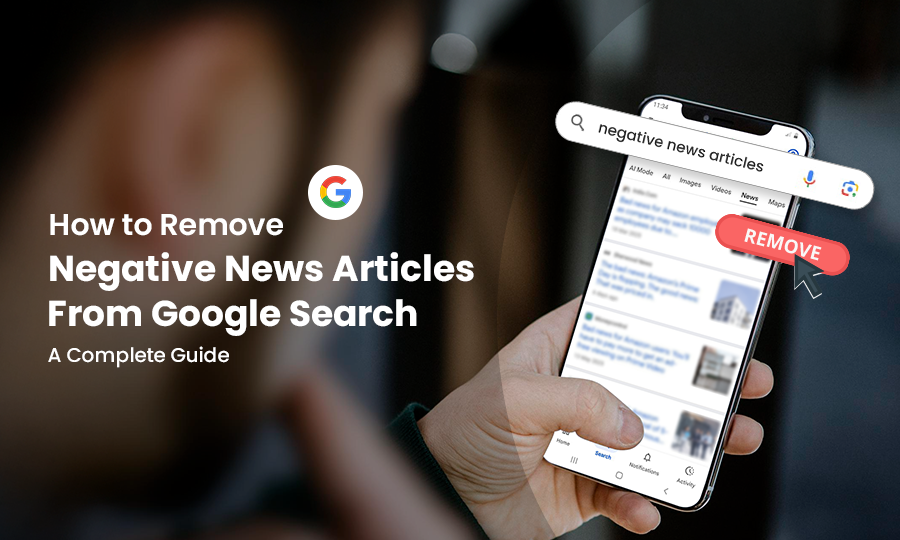Both positive and negative media coverage play a major role in your online reputation. If negative news articles about you or your business appear in Google search results, it can tarnish your online image and erode public trust. Thus, it’s crucial to remove negative news articles from Google search before they hurt your online image.
Did you know that the effect of negative news on reputation is three times larger than the effect of positive news? That’s why you need to develop impactful strategies to prevent negative news stories about you or your brand from going viral online.
In this blog, we’ve outlined several beneficial methods to help you remove or manage negative news stories from the internet. With our proven strategies, you can bury negative news articles beneath other search results and ensure that positive content about you or your business dominates the search engine results page (SERP).
What Is Considered a Negative News Article in Google Search?
In the context of Google search, a negative news article refers to a news story that shows a person or business in a negative light online. Such news stories are often about negative activities that can significantly damage an individual’s or a company’s online image.
Some Examples of Negative News Articles
Any publication, journalist, or media outlet can circulate negative online news pieces about you or your brand. Such news often appears on trusted news websites, which makes them more visible on Google search results. They can even appear on the first page of Google search results for years, if you don’t take the necessary actions.
Some common examples of such negative news stories are as follows.
- News coverage about a personal or professional controversy
- Reports on poor product quality or customer service failures
- Opinion blogs or editorials with a negative angle about a business or individual
- Coverage of legal disputes, violations of critical regulations, and data breaches, even after the legal charges are resolved
- Outdated news articles that suddenly resurface online, often related to old scandals
- Clickbait-style news headlines that exaggerate or misinterpret facts
- False or harmful claims presented online as facts
However, a single negative news story can adversely affect your online image. Here’s how a negative news article can impact a person or a business –
- Online reputational damage
- Loss of public/customer trust and credibility
- Financial losses like stock price drops and decreased investment
- Legal consequences like penalties, fines, and legal action
The news articles don’t have to be new to damage your online image, which you’ve built with your hard work and patience over the years. Even old articles can pop up on Google search and destroy your efforts to maintain a positive online reputation.
Can Negative News Articles Be Removed from Google?
No, Google generally doesn’t directly remove negative news stories from its search results. However, such news stories can be permanently deleted if they violate Google’s policies. There are also some strategic ways to handle negative online news stories. We’ve discussed those methods below.
Before the invention of the Internet, a single negative article used to have a specific life cycle. People used to read those news stories in newspapers and then forget about them after a while.
But now, the time has changed!
In today’s digital era, every single new article is available online, and anyone can access it anytime from anywhere. The internet has a permanent record of all the news. So when a negative news story about you circulates online, it stays on the internet forever.
And the most critical part here is that most of the online newspapers are more likely to rank well on Google search. Google’s policy is to provide information (no matter if it is positive or negative), and removing such news stories interferes with it. But certain methods can help you mitigate the visibility of such negative news articles or prevent reputational damage to some extent.
Pro Tip: We typically suggest you not try to remove a negative news story (if it’s not that important or unable to have much effect on your reputation) as it may backfire and draw more unwanted online attention.
How to Remove Negative News Articles from Google?
The process to remove negative news articles from Google can be a daunting task, as Google always prioritizes providing its users with relevant information.
Wondering how you can do this complex task effectively?
There are several tactful methods that can help individuals and businesses address and remove specific negative online news that appears as Google search results. Below, we’ve explained the top 10 strategies that you can implement to effectively manage or remove negative news stories from Google.
Note: We’ve tried to mention the easiest ways of removing negative online news, as the process is quite complex if you want to do it directly. Some indirect yet effective methods can help you ensure the successful removal of the negative online news.
Strategy 1: Document the Article You Want to Remove
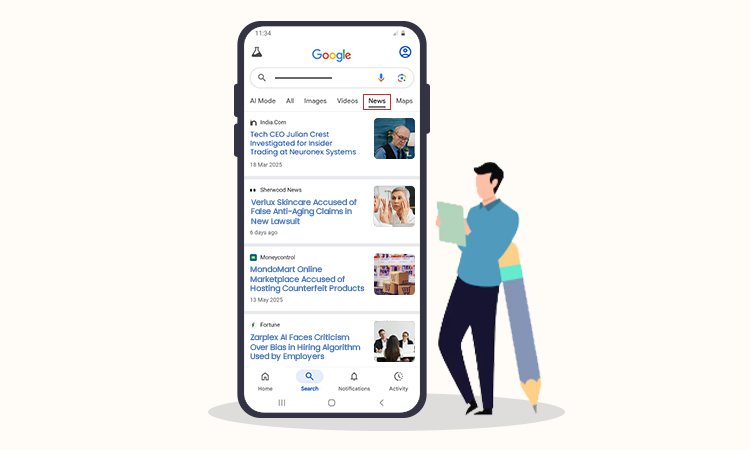
Many news sites syndicate others’ content. If you cannot see any negative news stories about you on the internet, it doesn’t mean that it’s not there. Thus, it’s crucial to identify every URL and track the news stories they’re publishing regularly.
Here’s how you can identify every site URL and document the news story you want to remove.
- You can perform a Google search using your or your brand name in incognito mode of your browser to get unmodified Google search results. In the search results page, you’ll get to see a list of webpage links. You can find the ‘news’ tab in the upper section of the page, where other content types are also mentioned.
- You need to click on the ‘news’ tab to see the online news articles. Observe the headlines of the negative news stories that you’ve found already. This will also help you find the other website links that have republished the same content.
- You can also search your job title, location, business industry, and any other identifiable information online.
- Don’t forget to check social media accounts. Yes, you heard it right! News articles often allow readers to share them on different platforms. According to a 2024 study by Nature, social media users are 1.91 times more likely to share links to negative news articles.
- So it is more likely that the negative news about you has been circulating on popular social media platforms like Facebook and Twitter. This way, you can track those websites that may not have ranked on Google, despite covering the same news.
- Create a list of all the websites you’ve found to cover negative news stories about you or your business. Document every URL, along with its search rankings and the keywords you’ve used to find them.
Strategy 2: Contact with the Source

This strategy is the most effective and easiest way to remove negative news articles online successfully. You need to reach out to the news organization/publisher/journalist/any other source to request the complete removal of the same.
Now the question comes – how can you find their contact information?
The easiest way is to check the contact page or the author bio page of that news website. You can also visit the journalist’s LinkedIn or Twitter profile to get their email address or newsroom contact details.
To request that they remove or edit the news story, you must be courteous and provide a detailed explanation of your problem. You can also mention how that negative news coverage is damaging your or your business’s online reputation. But that doesn’t mean they necessarily agree to remove the articles.
However, most publishers or journalists will agree to remove the information online if the content is inaccurate, involves legal issues, or raises valid concerns.
You can also mention if the news piece contains factually inaccurate or outdated information. Even if the article is factually accurate, you can still request the removal of that news article, if –
- It contains information that is no longer relevant, such as old legal charges or resolved financial disputes.
- It doesn’t contain a key context that can positively change how the news was perceived before.
- It contains disproportionately damaging facts and figures.
You can ask them to delete, de-index, or alter the negative news story to make it less visible in online search results.
Delete: What is better than completely deleting the news article from the internet? You need to convince the publisher to delete the news permanently. If they do it, the news will be pushed down in the Google search results within 1-2 weeks and will be completely removed after that.
De-index: This process requires the publisher to add a short piece of code to the webpage. Then the page will still exist, but no one can find it by Googling you or your brand. Most publishers prefer this as an alternative to the complete removal of the content.
It’s a win-win situation for both of you!
No one will find that news searching online, and the publisher doesn’t need to neglect their journalistic integrity.
Alter: Have new information regarding the negative news story? Can the new content help you rebuild your online reputation? If yes, then you can request the publisher to alter or update the news story with new information.
For example, removing your name from the title and headings of the news or from the article itself is the best option. Then the story won’t be ranking high or even found at all online!
Strategy 3: Send an Email or a Physical Letter to the Publisher

Now that you’ve all the contact details of the news publisher, you can connect with them via email. As you prepare your email content, you need to be polite, professional, and specific. Your email must explain why the news article is harmful to your reputation and should be removed from the internet.
Did you know that the average email open rate for most industries can be 21.33%? So you can safely consider email as one of the most effective media for communication. If you want to follow a traditional method, you can prioritize physical letters for this purpose.
Your email content must include:
- Why must the news story be removed?
- The timeframe you’re giving for the removal, depending on the urgency
- How has the negative news article damaged your reputation online?
- Proofs that the new article contains information that is factually incorrect, outdated, or misleading
A Sample Email Template to Request the Removal of a Negative News Article
Here is a sample email template that you can take as a reference. However, you can also make necessary changes to it according to your requirements.
“I am writing to request that you consider removing my name/my business name/web page at [the exact page URL]. The regret that the incident described happened. I would like to inform you that this incident happened over three years ago, and since then, our team has tirelessly worked to deliver the best possible service to our customers.
You can explore my official website to track our client testimonials and success stories. Today, our brand has more than 2000 happy clients and 8 renowned investors from all over the world.
The incident you’ve mentioned in that news is quite old, and the information no longer exists. I sincerely request that you remove my name from that article, as it may appear in the search results of my potential customers when they Google my brand name. It could be extremely damaging to my brand reputation and even my online image as an entrepreneur.
Would you consider removing, de-indexing, or changing this page on your site? Kindly reach out to me if you need any other references. Eagerly waiting for a positive response from your end. Thank you.”
Strategy 4: Reach Out to Every News Outlet to Request Removal

Don’t know which news outlet has published a negative news story about you? You need to reach out to every news outlet to ensure the removal of negative online information.
Make a list of popular and non-popular news outlet names and get in touch with at least one person from each outlet. Some publishing houses have their own policy of formal content removal. For such outlets, sending personal emails may not work!
Thus, you need to familiarize yourself with their formal process of filling content removal form and content unpublishing. Once you initiate the process, the negative news will be formally removed from the internet without any complexity.
Here are some factors you must remember while contacting news outlets to request that they remove negative news articles.
- Create a fill-in-the-blank template to make the process a little easier if you have a lot of major publications to contact.
- You can request specific changes in your content or request the removal of the entire piece.
- You need to cooperate with the news outlets if they ask for any type of documentation or follow-up before they make any changes to the news story.
- However, you should not entertain any unnecessary demands or threats. Otherwise, it can lead to negative press, and you may lose your potential chances of establishing contact professionally.
Strategy 5: Consider Google’s Right to Be Forgotten
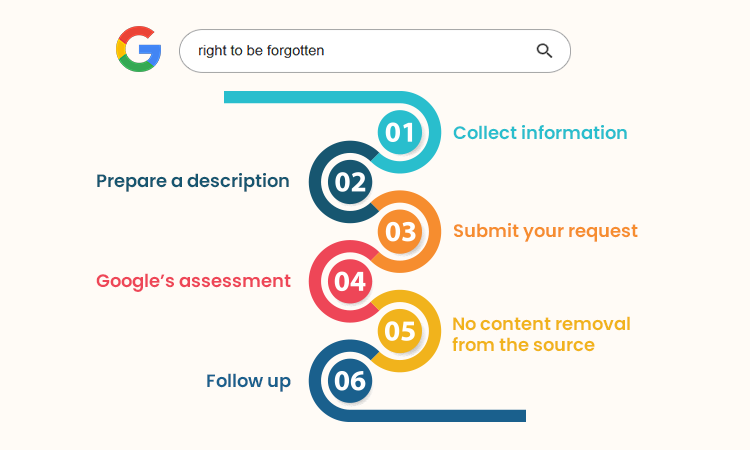
This is one of the most popular methods of removing negative news stories from the search engine results. Let’s first understand what the exact concept is.
What is Google’s Right to Be Forgotten?
It refers to a legal concept or a policy of Google that allows individuals to request the removal of their personally identifiable information from search engine results. However, this policy can be applicable only if the data is irrelevant, outdated, or exaggerated. It’s more like asking Google to forget about old news articles.
But it doesn’t erase the information from the original source. For example, a news website has posted a negative story about your brand. Google’s Right to be Forgotten will not remove a news article from the news website. Rather, it will prevent it from appearing in search results. So when someone searches for your brand on Google, he/she will not find it.
So you can ask Google to remove a certain old or irrelevant news piece that can hamper your online reputation. Google will prevent the visibility of that specific news story in its search results.
Note: This policy was first established in Europe, specifically for the ‘Google Spain case’. It required Google to delist information that was inadequate and irrelevant.
How Can You Use Google’s Right to Be Forgotten?
Let’s check out the process of using this policy to remove negative news stories from Google. Follow the steps mentioned below.
- Collect information: You need to identify the specific URLs of those negative news stories that you want to be removed.
- Prepare a description: It’s crucial for you to explain why the news story content is outdated, irrelevant, or misleading.
- Submit your request: Then, you can submit a request to Google to remove those links to the negative news articles from their search results.
- Google’s assessment: Google will evaluate your content removal request, examining the references you’ve submitted to support your claim. The team will also assess whether the news story is worthy enough to stay available online for public interest. For this, you may need to fill up a form and follow other steps as well.
- No content removal from the source: Google will not remove the news story from the website; rather, it will prevent it from appearing on search results for search queries related to you or your business.
- Follow up: Google may request additional information from you or communicate its decision to you (e.g., whether it agrees to remove the content or not).
Strategy 6: Ask Google to Remove News Article from Their Search Results
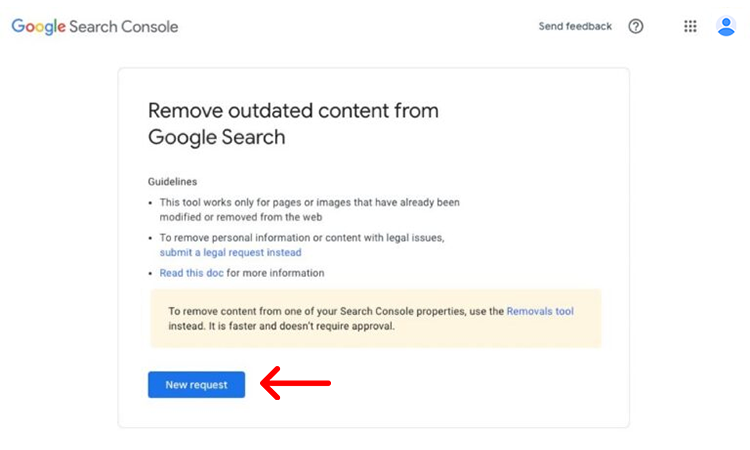
While you wait to hear back from Google about their decision to remove the news story, you can start taking other action directly within Google.
Anyone can find the news via a search engine till the time Google actually takes the final step to prevent the news story link from appearing in their search results. It can make a big impact on your online reputation while you wait for the permanent content removal.
Follow the steps to remove negative news articles online if they violate Google’s personal content policies.
- You need to submit a removal request directly to Google if the news story includes your personal information, involves copyright violation, or other critical cases.
- You can use the ‘remove outdated content’ tool to submit the request to remove a negative news story that is irrelevant but still appears in Google search results.
- You need to explain why the news should be removed according to Google’s guidelines.
- For legal violations, you can also report the news story.
Step-by-Step Process for Sending a Removal Request:
Find the specific search result/news story link > click on ‘More’ or the ‘three dots’ on the right of the search result > click on ‘Feedback’ > choose the issue from the list and explain it well in detail > click on ‘Send’ to submit your feedback
Step-by-Step Process for Reporting a Negative News Article:
Click on this link
https://support.google.com/legal/troubleshooter/1114905?sjid=942691269060075109-NC&authuser=2 > select the Google product (such as Google Search, Google Maps, or Blogspot) where the new story you want to report is appearing > follow the further process as appears
Strategy 7: Use Google’s Tools

Do you know that having four or more negative news articles about you or your business in Google search results can make you lose around 70% of potential customers?
The only way to prevent this loss is to remove the negative news story from Google. Apart from Google’s Right to be Forgotten and other online content removal processes, you can find several useful tools within Google Search Console.
How do These Tools Work?
With the help of these tools, you can manage or control how your website’s content appears in Google search results. They allow you to temporarily remove URLs and clear outdated content snippets. You can even completely delete outdated content by using these content removal tools.
However, this can only be possible if you’re the verified owner of the website in Search Console. Let’s know how you can use these tools.
- You need to open the Removals tool in Search Console by selecting the ’ Temporary Removals’ tab.
- Click on ‘New Request’ and choose “Temporarily remove URL” or “Clear snippet in search”.
- After that, you need to enter the URL you want to remove and click ‘Submit’.
This process will help you hide the news article URL from Google search results for about six months and clear the cached copy. This is a temporary solution, and the news article may rank again in Google search results after a specific period. To completely remove the news, you need to follow the above-mentioned steps.
How to Remove Outdated Content from Google?
You can follow these steps to remove news stories that contain outdated information. You can prevent the URL from appearing more often in search results.
Open the Removal tool in Search Console > select the ‘Outdated Content’ tab > enter the page URL or image > click ‘Submit’ > provide at least 1-2 words that were presented in the snippet of the search results but are no longer relevant
However, a successful content removal depends on what Google assesses about your request. If it finds your request genuine and your claims accurate, it will suppress the negative news article link in its search results. You can seek negative news article suppression services from reputable agencies.
Strategy 8: Suppress Negative Search Results
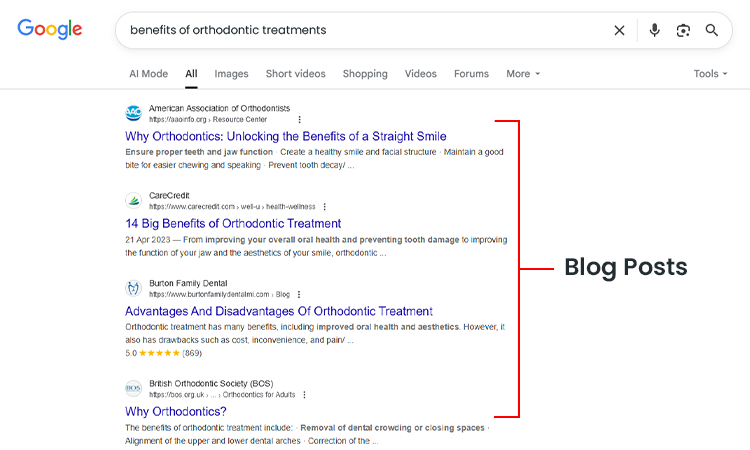
Sounds complex, right?
But the process is not as complex as it seems. You need to create high-quality, positive content to use as a defence against the negative news articles in search results. The positive content will outcompete the negative news stories in Google search results.
Explore how you can push down negative search results.
- You can create new blog posts containing the expertise, achievements, and positive attributes about you as an individual or your business. You can explain which factors make you different and use keywords that you want your or your business name to be associated with.
- Prioritize achieving guest posting opportunities from authoritative sites in the same niche as yours. Such reputable sites often have high domain authority that can help you outrank negative news articles.
- To remove negative news articles and suppress them in search results, you need to post high-quality, engaging content on social media platforms like Facebook, Twitter, Instagram, and LinkedIn. It will ensure your social media profiles are well-indexed in search engine results. Never forget to make the content keyword-rich to rank it for relevant online search queries.
- If you have a bio page on your official website, you need to improve the content present on that page to rank it on search engine results pages. You can increase the content length and incorporate relevant keywords in the title, meta description, site URL, and image alt texts to inform search engines what your page is about.
- The next step is link-building for your positive articles and posts. You need to interlink all your positive blog posts and other digital assets to inform Google that they are all relevant to your business.
For example, a dentist can interlink the service page of their orthodontic treatments in a blog about ‘benefits orthodontic treatments can offer’. Right interlinking is a great way to rank your content better and promote multiple pages of your website in a single content.
These steps, if effectively followed, can help you suppress negative search results about your business or yourself.
Strategy 9: Take the Legal Route

What if nothing works in your favor?
This question must have come to your mind! We suggest you take legal action in case of such situations. You can request the removal of specific negative news articles if they violate Google’s policies or local laws. Legal remedies can be given priority if –
- The negative online content has revealed personal information.
- The negative content contains explicit or defamatory material.
You can visit Google’s Content Removal Request page https://support.google.com/websearch/contact/content_removal_form?hl=en to file your case against negative news stories. Certain municipal regulations can assist you in removing those unfavorable news items, so you can consult a local attorney for legal counsel.
Depending on the jurisdiction and the nature of that negative news, you can pursue a defamation lawsuit or secure a legal order to remove the content. Speak to a lawyer to determine whether you can request the removal of the negative news articles.
They can recommend sending an attorney/cease and desist letter to the news outlets to put pressure on them if they’re not ready to take down their news articles.
Strategy 10: Plan a Positive News Campaign and Publish Press Releases
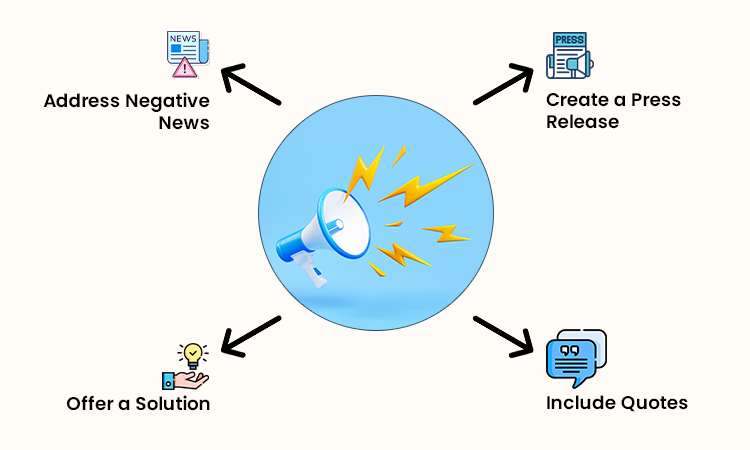
Just like updating your existing content, you can publish news content on your own website to highlight the positive aspects of yourself or your brand. This way, you can plan a positive news campaign to add value to your community.
You need to be authentic – doing some grand gestures for your consumers, for the sake of those negative news articles, can make things worse.
Another effective thing you can do is to publish press releases to address the negative online news articles. Press releases are the best medium to share your side of the story with the audience and correct the misinformation. Through this, you can offer a more positive perspective and win back public trust.
Here are some important tips to create a newsworthy press release and effectively remove negative news articles online.
- Address Negative News – You can acknowledge and analyze the negative news, identify the core issues, and decide what aspects you must address.
- Create a Press Release – Craft a newsworthy press release and make it attention-grabbing. You can briefly explain the situation and your perspective regarding the negative news.
- Offer a Solution – It’s best to offer a solution as well, such as the actions you’ve taken or plan to take to resolve the issue at the earliest.
- Include Quotes – Incorporating quotes from relevant individuals can add credibility and a touch of personalization to your press release.
- Provide Contact Information – Don’t forget to provide accurate contact information in your press release.
- Target Reporters – It’s crucial to identify and target reporters and editors who cover a specific topic of negative news.
- Send Emails to Journalists – You can email those journalists and explain why your press release is relevant to their audience.
- Distribute Your PR – The final step is to distribute your press release through reputable services like PRWeb, Business Wire, or GlobeNewswire. It’ll help you distribute your press release to a wide network of media outlets.
Why Do Negative News Articles Rank So High on Google?
Yes, Google ranks negative news articles high in its search results.
You may find it quite weird, but it’s true. Since most online newspapers rank well in Google, the negative article has a good chance of appearing on the first page of it. Even the local newspapers have a noteworthy online presence in today’s competitive digital landscape.
Wondering why it happens? Let’s understand it in detail.
Google prefers relevant, compelling, and authoritative content and tends to prioritize it in ranking, no matter whether the content is positive or negative. If a negative content contains essential details and all the possible information it can provide to people, it is more likely to rank on Google.
The Google search algorithm is quite complex, which shows results that are both popular and relevant.
According to study by Nature, the click-through rates tend to increase by 2.3% for each negative word present in a news headline of average length (14-15 words). This study reveals that a larger proportion of negative words in a new headline makes it more likely for users to access the story.
So, because of the popularity of negative news articles, they are more likely to rank higher in search engine results. In simple words, negative news stories rank in Google because:
- It evokes a strong emotional response.
- It has higher levels of user interest and engagement, which is referred to as ‘negativity bias’ (a psychological condition that makes people more interested in unfavorable information or events.
- It is published on highly reputable and authoritative sites.
- It generates clicks and user participation due to its attention-grabbing nature.
- It contains keywords closely associated with a prominent name of a brand or an individual.
What to Expect from Negative Press Coverage?
In the widest scenario, negative press coverage can cause extreme online reputational damage to a person or a business. How much damage it will cause to your reputation doesn’t depend on whether the news coverage is accurate or not. That’s why it’s crucial to prepare a robust plan to remove negative news articles that can harm your online reputation.
Public opinions change fast, and news stories and media mentions highly influence how the public sees you, your business, and your work. Once there is negative media coverage about you, and it starts circulating online, it leaves a bad impression on your potential customers, clients, and even investors.
Short-term Impact of Negative Media Coverage
The following are some short-term impacts you can have if there is any negative news coverage about you or your business.
- Bad first impression on potential customers, investors, partners, and clients
- Negative news stories rank higher in search results when someone Googles your name or your business name
- Increase in negative online attention, such as social media backlash, trolling, negative reviews, and comments
Long-Term Effects of Negative Media Coverage
Here are some long-term and more crucial effects of negative media coverage.
- Professional setbacks like missed career or business opportunities
- Reduced customer trust and poor brand perception
- Constant appearance of the negative news article in search results, even after the issue is resolved
FAQs
Here are some frequently asked questions related to the removal of negative news articles from Google.
Ans. It often occurs for different reasons. Some of the examples are your brand delivering poor quality products, has experienced customer service failure recently, or a competitor may want to show your brand or your personality in a negative light online. The media may cover negative news about your brand due to your involvement in a legal dispute, a regulatory violation, or a customer data breach. You can conduct detailed research on your brand’s history to identify the issue.
Ans. Yes, you may. But the cost may vary depending on several factors. If you contact the website owner directly, he/she may or may not delete the news article free of charge. Apart from these, there are legal expenses as well in case of any conflicts. Individuals who are from regions where Google’s Right to be Forgotten is applicable can request content removal from Google without any expense. However, you may need to invest money in hiring a good online reputation management company to achieve a favorable outcome.
Ans. It depends on the number of negative news links and keywords for which the news is ranking. The timeline also depends on which method of removal you’ve selected. You can regularly follow up with the publishers, but it cannot guarantee the duration within which they will respond to your removal request. If you hire an agency for their online reputation management or online content removal services, it will take approximately 3-6 months to suppress the negative search results.
Ans. No, it is not necessary to hire a defamation attorney. Hiring a lawyer may or may not be necessary depending on the situation. In many instances, it is enough to seek professional help from a reliable online reputation management agency. Because most of such agencies have an expert team, capable of removing or deleting negative news articles efficiently and quickly.
Ans. No, especially when the news article contains factually correct information at the time of its publication. You cannot lodge a defamation case in such cases. To claim it, you need to prove that the news article contains false information since the time it was published. If the news invades privacy rights, contains false statements, or outdated information, you can take legal action. However, the court can order the removal or de-indexing of the news article through defamation lawsuits or privacy claims.
Conclusion
No matter if you own a large enterprise or are a prominent social personality, the media can cover negative news stories about your business or you as an individual for various reasons. The impact doesn’t depend on the reason; it adversely affects an individual’s or brand’s online reputation and erodes public trust.
Just like every reputational struggle, this also has a solution. Businesses or individuals can implement certain strategies to remove negative news articles from Google or prevent those from appearing in Google search results. You can follow the mentioned methods to remove such negative online news about you or your brand. Our strategies will immensely help you to ensure the success of the removal process and rebuild public trust.
Still have doubts? You can hire a reputable online reputation protection agency for your brand or seek personalized online reputation monitoring services for yourself.

